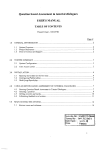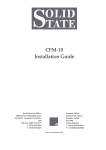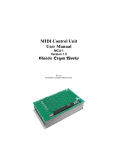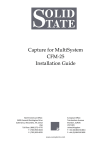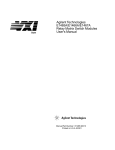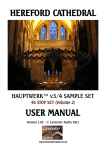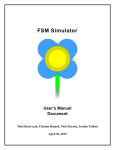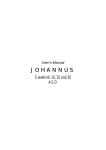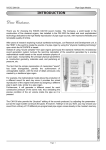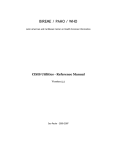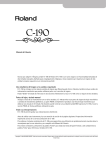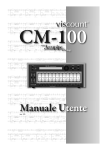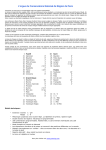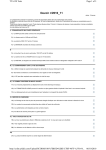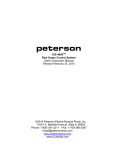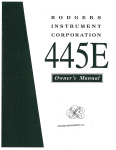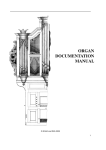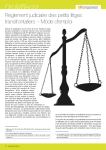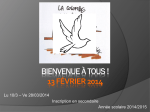Download user`s manual - Pascal Leray
Transcript
ORGAN HARDWARE BOARDS For REAL or VIRTUAL PIPE ORGANS USER’S MANUAL September 2012 Pascal Leray Dr-Engineer R&D for ORGANBUILDERS [email protected] http://pascal.leray.free.fr Page 1 SUMMARY : Building at very low cost a small or huge pipe organ is now available : Our set of organ hardware electronic boards allows now any organbuilder to design and build any small or large pipe organs. Even old trackers, new or refurbished register pipe organs, classic or recents can use our hardware set. Only 4 items are necessary : • Input board : Which can receive up to 8 keyboards/pedal • Opto isolated Interface board, which can drive power output boards • Output boards, available in 2 versions : 64 outputs with Darlingtons or 4x64 outputs with integrated Darlingtons. • A standard PC with parallel interface. (even recent, low cost PC’s are available with Parallel interface. All these boards can be controlled remotely. Using telecommunication lines for very long distances (concerts were done with 100 km distance between keyboards and the pipe organ), or 100m using USB interface All these boards can be controlled by MIDI interface from the PC, without additional hardware. They have all a separate 5V input regulator. A separate 7,5V power supply is sufficient. INPUT BOARDS : PART 1 : MIDI/USB interfaces : 1. KI_5_FATAR_USB: This board can drive any 8x8 matrixed keyboards/pedal. Such as FATAR, M-AUDIO keyboards, and so on. With only 1 micro USB output. 2 modes : 5x1x8x8 matrices; or 2x2x8x8 matrices, and pedal. MODE 1 : with 5 8x8 matrix. Can drive jeyboards with merging their 2 high low part connectors. MODE 2 : receives directly the 2 red connectors from each keyboard. The board can drive also an analog expression pedal. Easily reconfigurable. No additional power supply : Supply only by the USB port. Very fast response time, with a powerfull 90MHz ARM microprocessor. Can be devlivered for 6 8x8 matrices connectors. Page 2 2. KI_7_MIDI_USB : Can be used with classic organ keyboards without contact nor matrix connectors. Can drive up to 7 LI_64 inputs, or the direct 2xK32 boards, which can be directly plugged at the rear of any organ keyboard. This board has a direct USB/MIDI output, easily reconfigurable. Can drive an analog expression pedal. Each connector can be connected to a KI_64 input. (see under). 3. KI_64 : This board can drive up to 64 inputs : Manual or pedal keyboards. With direct contacts, ILS, opto electronic or HALL effect (magnetic)sensors. 12V standard input. Connects any KI_7_MIDI_USB boards. 4. KH32 See under Page 3 5. PART 2 : DIRECT PARALLEL INTERFACE BOARDS Using the standard Parallel port interface from PC’s. VERSION 1 : • • 8 keyboards in input. Output on parallel port VERSION 2 : • 8 keyboards in input • MIDI outputs Several input boards can be used. And more keyboards can be added, which can share as you want some or all registers of the pipe you control. VERSION 3 : 64 Input boards can be also directly connected to the input board, on one of the 8 inputs. VERSION 4 : A second model of 64 input board is also available, directly connected to the following interface boards. Opto-isolated thanks to the parallel interface board. Active “on” level is detected by a low level (ground) 0V in input. All inputs are clamped to VCC : +5V. KEYBOARDS INTERFACE : KH32 Input boards can be connected to KH32 electronic bars, which are composed of 2 sets of 32 inputs. These bars can be plugged directly at the rear of any real pipe organ keyboard. Other connections are also possible using the version 4 interface, with classic contacts or optoelectronic sensors. Our keyboard interface board can receive one or two sensors, for detecting the “on” or “off” key position. Velocity can be sent with the input board in MIDI version. Page 4 PARALLEL INTERFACE BOARD : CIPAR This CIPAR board receives output information from the organ controller running on the PC, via a standard parallel port. 1 It isolates the PC from the power output boards, thanks to an opto-electronic interface. Outputs a demultiplexed parallel bus, allowing parallel 8 bit access to magnet valves. A standard DB25 parallel connector can link any PC to these board. At present, a direct USB port is also available. This parallel board can drive any real pipe organ, with resistor or inductive loads such as magnets or heavy duty magnets. The parallel connector OUTPUT POWER BOARDS : Our 64 or 4x64 boards can be plugged to any PC, via the standard PC parallel port. Addresses are defined on the “options.wri” file. Power supply 5V, via a regulator. VERSION 1 : CSP1X64 • 64 power outputs. Each of these outputs can drive up to 7 Amps Discrete Darlingtons are soldered on the boards. For heavy duty outputs, drawstops, and so on. Can drive several registers in parallel, or drawstops, or toeboards. 1 Don’t think that parallel port is no longer available on PC’s : Even brand new, cheap and small but powerfull MINI-ITX PC’s are on the shelves. And classic desktops can also receive parallel port interface on their PCI bus. Page 5 VERSION 2 : CSP4x64 • • 4x64 power outputs with 4 x 64 pins connectors CI integrated Darlingtons can be put on the board, or soldered directly on the magnets. These boards can be placed on a standard 19’ Rack, with the opto-isolated interface board, connected to the PC. 15 boards can be easily placed on a rack, allowing direct control of 60 independent unit registers. Of course, several racks can be driven in parallel for unlimited stop number. Of course, this board can also drive register windchest division, or several registers in parallel. TO CONCLUDE : That’s all ! With this electronic board set, one can build organs any sizes. You can use also “ORGAN DESIGNER SOFTWARE” for windchest design and automated machine tool drilling, and “ORGAN CONTROLLER SOFTWARE” for controlling the input and output boards. All these sets can be driven remotely, via a telecommunication line, or a cheap, long distance dual plug USB to Ethernet interface. (see our website : http://pascal.leray.free.fr). PC to be used : Any desktop PC can be used for controlling these boards. Add-on parallel boards can be added, with even dual parallel ports. Very cheap PC such as MINI ITX PC’s can be used. Several screens and touch screens can also be used. All are supported by our “ORGAN CONTROLLER SOFTWARE”. Boot duration process is less that 30s. Of course, one must load only a WINDOWS system without any add-in exe files. It’s the only constraint for the use of WINDOWS/PC based software. But really speaking, when we are switching “on” a Page 6 classic organ, how much time do we spent for selecting our scores, waiting for the blower, switch the lights, and so on ? ADVANTAGES : Advantages # is huge: • You become hardware independent, given the enormous PC offering worldwide. • Memory extensions, disks, screens are very cost effective. • Unlimited registration number. • The PC world is very cost effective, due to the number of competitors. • PC boards are using classical IC components, such as 74541, 74574, which are always available worldwide. • These component never fail. • Use a battery based inverter, and you’ll became independent of any overvoltage. • SOFTWARE FLEXIBILITY : thanks to ORGAN CONTROLLER, many features are now available WITHOUT ADDITIONAL HARDWARE: o Transposer o MIDI inputs and outputs o Displayed registration number. o Tremulant : variable frequency, for each register. o Pedal split o Multiple registration set per organist, defined as PC files. o Expressive sensitive keyboard keys. o Envelope curve. o Flexible drawstops display o Real drawstops and pistons can also be used. o Copy – Paste of registrations o Name for registrations. o Unlimited copulas. o All registers can be actuated from any keyboards o Independently of other keyboards : for example a trumpet can be actuated at the pedal, o Each keyboard can be defined with the stops you want. (can be defined by organbuilders or organists). o Mixturs can be defined by text files. o All stops can be actuated in 16’, 8’, 4’ 2’ feet and even tierce, quint, and so on. o Reed Mixturs can also be programmed, thanks to a simple text file. (see below). Page 7 ANNEX 1 : Options.wri file (example) Here is an example of how register addresses are simply defined for each register. PORT_BASE 378 PORT_BASE_HALL SCREENS 2 STOPS 24 BOURDON FLUTE 4 FLUTE 8 MONTRE DULCIANE NAZARD SOUBASSE PRESTANT QUINTATON DOUBLETTE REGALE HAUTBOIS TROMPETTE VOX HUMANA FLUTE_HARM BOURDON4 GAMBE CORNET PLEINJEU FOURNITURE CROMORNE VCELESTE TROMPETTE4 TIERCE 378 ;FF;BOARD1X64;FLUTE ;F7;BOARD1X64;FLUTE ;CF;BOARD1X64;FLUTE ;EF;BOARD1X64;PRINCIPAL ;C7;BOARD1X64;FLUTE ;D7;BOARD1X64;FLUTE ;7F;BOARD1X64;FLUTE ;27;BOARD1X64;PRINCIPAL ;3F;BOARD1X64;FLUTE ;2F;BOARD1X64;FLUTE ;AF;BOARD1X64;REED ;B7;BOARD1X64;REED ;E7;BOARD1X64;REED ;DF;BOARD1X64;REED ;4F;BOARD4X64;FLUTE ;A7;BOARD4X64;FLUTE ;BF;BOARD4X64;FLUTE ;00;BOARD4X64;FLUTE ;00;BOARD4X64;MIXTUR ;87;BOARD4X64;MIXTUR ;0F;BOARD4X64;REED ;07;BOARD4X64;FLUTE ;37;BOARD4X64;REED;T ;47;BOARD4X64;PRINCIPAL;t ANNEX 1 : MIXTUR EXAMPLE : VIRTUAL REGISTER EXAMPLE fourniture dax 4 rank n°1 (keyboard GO) " l= LARIGOT " " p= PRESTANT4 " M=MONTRE 1 2 3 4 5 6 7 8 9 10 11 32 M 37 M 44 M 33 M 38 M 45 M 34 M 39 M 46 M 35 M 40 M 47 M 36 M 41 M 48 M 37 M 42 M 49 M 38 M 43 M 50 M 39 M 44 M 51 M 40 M 45 M 52 M 41 M 46 M 53 M 42 M 47 M 54 M Page 8 12 13 14 15 16 17 18 19 20 21 22 23 24 25 26 27 28 29 30 31 32 33 34 35 36 37 38 39 40 41 42 43 44 45 46 47 48 49 50 51 52 53 54 55 56 END 43 M 48 M 55 M 37 M 44 M 49 M 38 M 45 M 50 M 39 M 46 M 51 M 40 M 47 M 52 M 41 M 48 M 53 M 42 M 49 M 54 M 43 M 50 M 55 M 44 M 51 M 56 M 45 M 52 M 57 M 46 M 53 M 58 M 47 M 54 M 59 M 48 M 55 M 60 M 49 M 56 M 61 M 50 M 57 M 62 M 51 M 58 M 63 M 47 M 52 M 59 M 48 M 53 M 60 M 49 M 54 M 61 M 50 M 55 M 62 M 51 M 56 M 63 M 52 M 57 M 64 M 53 M 58 M 65 M 54 M 59 M 66 M 55 M 60 M 67 M 56 M 61 M 68 M 57 M 62 M 69 M 58 M 63 M 70 M 52 M 59 M 64 M 53 M 60 M 65 M 54 M 61 M 66 M 55 M 62 M 67 M 56 M 63 M 68 M 57 M 64 M 69 M 58 M 65 M 70 M 59 M 66 M 71 M 60 M 67 M 72 M 61 M 68 M 73 M 62 M 69 M 74 M 63 M 70 M 75 M 64 M 71 M 76 M 65 M 72 M 77 M 66 M 73 M 78 M 67 M 74 M 79 M 68 M 75 M 80 M Page 9










